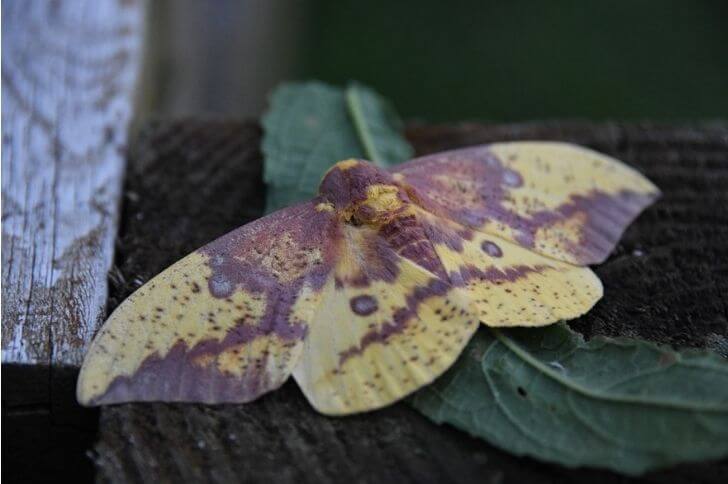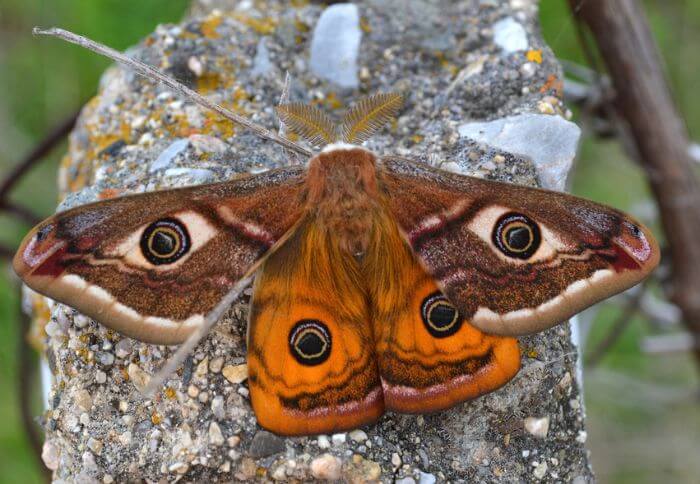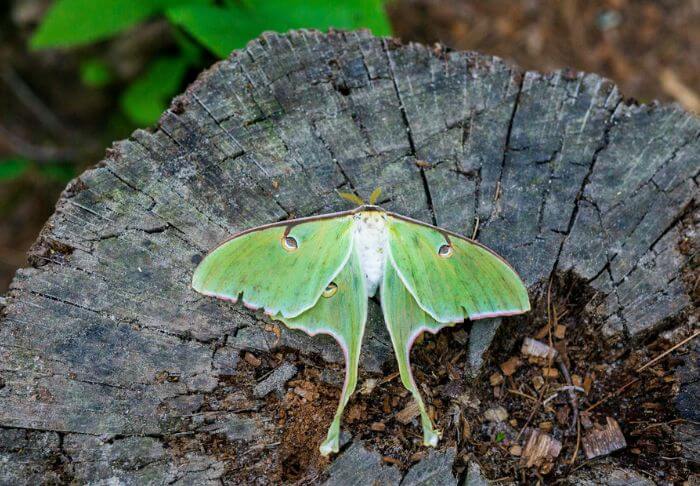11 Yellow and Brown Moths (Id & Images)
Did you know that moths come in a stunning array of colors and patterns? While we often associate these nocturnal creatures with dull shades of gray and brown, there is a whole world of yellow and brown moths waiting to be discovered.
From vibrant lemon yellows to rich chocolate browns, these enchanting insects are not only beautiful but also play a vital role in our ecosystems. So, get ready to delve into the captivating realm of yellow and brown moths as we explore the diverse species that grace our skies.
Yellow and Brown Moths
1. Imperial Moth

The imperial moth, with its impressive size and intricate patterns, is undoubtedly a showstopper in the world of moths. With a wingspan that can reach up to 7 inches, it is one of North America’s largest native yellow and brown moths.
Unlike many other species that blend into their surroundings for camouflage, the imperial moth flaunts its vivid colors for all to see. Its wings are adorned with a striking combination of yellows, oranges, purples, and browns that create a mesmerizing display when in flight.
Despite its majestic appearance, the imperial moth’s life cycle remains relatively unknown to many. These creatures undergo a fascinating transformation from egg to caterpillar and finally emerge as adults after spending several weeks or even months underground as pupae.
However, sightings of the adult moth are scarce due to their mostly nocturnal nature and limited lifespan focused on reproduction. Those lucky enough to spot this beauty can marvel at its ephemeral presence while contemplating the mysteries hidden within its short yet remarkable journey.
2. Half-Yellow Moth
The Half-Yellow Moth, with its unique and striking appearance, is a true wonder of nature. With one half of its wings bright yellow and the other half a deep brown shade, this moth stands out among its peers. But what purpose does such an unusual coloration serve?
Scientists believe that it could be a form of mimicry, allowing the Half-Yellow Moth to blend seamlessly into its surroundings. When resting on tree bark or foliage, the yellow side mimics patches of sunlight filtering through the leaves while the brown side matches tree trunks perfectly. This ingenious adaptation serves as protection from predators and enhances their chances of survival.
Another theory suggests that the asymmetrical coloration is a result of genetic mutation. Similar to human conditions like heterochromia (different colored irises), this phenomenon occurs when there is an imbalance in pigmentation during development.
The result is a stunning pattern that has intrigued scientists for years. It’s fascinating to think about how chance mutations can create such intricate beauty in the natural world.
The Half-Yellow Moth teaches us to appreciate the extraordinary diversity found all around us and reminds us that even small creatures can have a big impact on our perspective of nature’s wonders
3. Polyphemus Moth

Polyphemus Moth, with its unique combination of yellow and brown patterns, is a sight to behold. Named after the cyclops in Greek mythology, this moth stands out among its counterparts due to its extraordinary eye-like markings on each of its wings.
These markings not only serve as a defense mechanism against predators but also add an element of intrigue to this already mesmerizing creature.
One fascinating feature of the Polyphemus Moth is its immense size. Spanning over four inches from wingtip to wingtip, it holds the title for being one of the largest brown and yellow moths in North America.
Such an impressive stature allows it to dominate the skies and effortlessly capture attention wherever it goes. Additionally, despite their large size, these moths are incredibly agile flyers, capable of gracefully maneuvering through even the densest forests.
Another captivating aspect about these stunning insects lies in their lifecycle. Like many other yellow and brown moths, the Polyphemus Moth undergoes a remarkable transformation from caterpillar to adult moth. The caterpillars begin their journey as tiny larvae that feed voraciously on various deciduous trees such as oak and maple.
As they grow larger and consume more leaves, they eventually spin a cocoon around themselves using silk threads produced by special glands near their mouths. Within this protective casing, they undergo metamorphosis until emerging weeks later as fully formed adult moths.
4. Garden Webworm Moth
The Garden Webworm Moth is a small, yet fascinating insect that belongs to the family Noctuidae. This moth can be found in various parts of North America, where it tends to inhabit gardens and other green areas.
What sets this moth apart from others is its unique coloration and behavior patterns. With its wings showcasing a stunning combination of yellow and brown, the garden webworm moth effortlessly blends into its surroundings, making it difficult for predators to spot.
What makes the Garden Webworm Moth particularly intriguing is its feeding habits. As their name suggests, these moths are known for creating silk webs within plants, which they use as hiding spots during both rest and feeding periods.
These webs serve as not only protective barriers but also catchers for unsuspecting insects that cross their paths – acting as convenient meals for the moth larvae within.
It’s a remarkable example of nature’s ingenuity at work, where the moth manages to exploit its environment effectively in order to ensure survival and create a perfect home for future generations.
Related Read: Small green caterpillars
5. Deep Yellow Euchlaena Moth
One of the most intriguing members of the yellow and brown moth family is the Deep Yellow Euchlaena Moth. With its vibrant lemon-yellow wings and intricate brown patterns, this moth immediately catches people’s attention.
What makes it even more captivating is its behavior – unlike many other moths that fly at night, the Deep Yellow Euchlaena Moth prefers to be active during daylight hours, making it a rare sight for those lucky enough to spot it.
When examining this moth up close, one cannot help but be astounded by its wing design. The pattern on the wings resembles delicate brushstrokes of brown paint on a bright canvas.
This unique design likely plays a key role in camouflage, helping the Deep Yellow Euchlaena Moth blend seamlessly into its surroundings when at rest.
However, as soon as it takes flight and those wings open up to reveal their stunning yellow coloration, it becomes clear that this moth is not meant to go unnoticed.
Found primarily in tropical rainforests across Central America and Mexico, these brown and yellow moths are known for their preference for feeding on nectar from various flowering plants.
Their proboscis – a long tube-like structure – allows them to extract sweet liquids from deep within flowers with ease. This specialized adaptation has contributed greatly to their ability to thrive in their lush habitat and ensures that they have plenty of untapped food sources available.
6. Common Idia Moth
The Common Idia Moth, also known as the Idia aemula, is a striking and vibrant species that can be found throughout India and parts of Southeast Asia.
This moth is notable for its stunning yellow wings that are adorned with intricate brown patterns, resembling delicate brush strokes on a canvas. The contrast between the bold yellows and earthy browns gives this moth a unique and captivating appearance.
One fascinating aspect of the Common Idia Moth is its ability to adapt to various habitats and climates. It has been observed in both urban areas and natural environments, showcasing its resilience and versatility.
This ability to thrive in different settings suggests that this moth species has evolved over time to make the most of its environment by blending in or standing out as needed.
Another interesting feature of the Common Idia Moth is its lifecycle. Like other moths, it undergoes complete metamorphosis from egg to larva (caterpillar) to pupa (cocoon) before finally emerging as an adult moth.
Despite being nocturnal creatures, these moths often lay their eggs on plants during daylight hours, providing food for their offspring once they hatch.
7. Basswood Leafroller Moth
Basswood Leafroller Moths, with their striking yellow and brown wings, are a captivating sight to behold. This species can be found across North America and is often seen fluttering around in woodland areas.
What sets this moth apart is its unique method of protecting its eggs during the winter months. Instead of laying them directly on tree bark like other moths, the female Basswood Leafroller Moth wraps her eggs inside specially constructed leaf rolls.
These leaf rolls provide insulation and protection for the developing larvae against cold temperatures and predators.
Another interesting aspect of this yellow and brown moths life cycle is its preference for basswood trees as host plants. The larvae feed exclusively on the leaves of basswoods, creating curled edges or rolled leaves as they consume the foliage.
This behavior has led to it being called a leaf roller, as it constructs shelters within curled leaves while going through various stages of development.
While some might dismiss moths as dull or uninteresting insects, taking a closer look at species like the Basswood Leafroller Moth reveals their fascinating adaptations and strategies for survival in their environments.
From their unique egg-laying behaviors to their specialized relationship with specific host plants like basswoods, these moths offer an opportunity to appreciate nature’s intricate web of interconnections even in seemingly small and insignificant creatures.
8. Large Maple Spanworm Moth
The Large Maple Spanworm Moth, with its delicate yellow wings and intricate brown patterns, is a fascinating creature that often goes unnoticed. While this brown and yellow moth may not have the vivid colors or striking patterns of other species, its subtle beauty creates a sense of understated elegance.
Unlike some yellow moths that are active during the day, the Large Maple Spanworm Moth emerges at dusk and dawn, blending perfectly with its surroundings as it flutters from one leaf to another.
What makes this species even more intriguing is its lifecycle. The larvae of the Large Maple Spanworm Moth feed on maple trees and other deciduous plants, creating unique artistic patterns on the leaves as they munch their way through.
This process not only adds a touch of intrigue to nature’s canvas but also serves as a natural pruning mechanism for these trees. As adults, these moths play a crucial role in pollination by transporting pollen from one plant to another in their quest for nectar.
Observing the behavior and habitat preferences of the Large Maple Spanworm Moth provides us with valuable insights into its ecological significance.
Despite being less flamboyant than some of its counterparts, this moth proves that beauty can be found in subtlety. Its ability to blend into its environment with ease reminds us that sometimes it is those who don’t demand attention that deserve our utmost admiration.
9. White-Dotted Prominent
The White-Dotted Prominent, scientific name Nadata gibbosa, is a moth that perfectly embodies the beauty of nature. With its pale yellow wings patterned with intricate dark brown markings, this species stands out in a crowd of moths.
What makes it even more fascinating is the distinct arrangement of small white dots along the edges of its wings, which gives it a unique appearance.
One interesting fact about this yellow and brown moth is its impressive size. With an average wingspan ranging from 2-3 inches, these moths are quite noticeable when in flight during dusk or dawn. In terms of habitat, they primarily reside in deciduous forests and woodlands across North America.
Another intriguing aspect of this species lies in its behavior. Unlike many other moths that are nocturnal, the White-Dotted Prominent is crepuscular – active during twilight hours when visibility is still relatively good. This adaptation allows them to take advantage of available light while minimizing exposure to potential predators.
Though perhaps not as widely recognized as some other moth species, the White-Dotted Prominent certainly has its own distinct charm and allure.
10. Hickory Tussock Moth
Hickory Tussock Moths may be small in size, but they certainly pack a punch when it comes to their appearance. With their distinct white and black fuzzy caterpillars, this species grabs attention wherever it goes.
But there’s more to this moth’s caterpillar than just its striking looks. Did you know that the hairs on their bodies can cause skin irritation? These hairs contain a toxin that causes redness, itching, and even blisters in some individuals. While this may deter predators from attacking them, it also serves as a reminder to us humans to admire these creatures from a safe distance.
Beyond its potential harm to humans, the Hickory Tussock Moth also has an interesting life cycle worth exploring. After hatching from eggs laid by adult moths in late spring or early summer, the caterpillars undergo several molts before entering the pupal stage.
This stage lasts until the following spring when the adult moths emerge and repeat the cycle all over again. It’s fascinating how nature has designed these insects to survive through seasons and continue their lineage generation after generation.
11. Horned Spanworm Moth
The Horned Spanworm Moth is a stunning creature that belongs to the family Geometridae. This moth species derives its name from the unique horn-like projection on its head, which gives it a fascinating appearance.
Found in various parts of North America, these moths display an incredible range of colors, including shades of brown and yellow.
One interesting fact about the Horned Spanworm Moth is that their caterpillars are known for their distinctive looping gait as they move along plant stems. This peculiar movement earned them the nickname inchworms.
Another captivating aspect of this moth species is their remarkable ability to blend seamlessly into their surroundings. With their intricate patterns and subtle hues, they have evolved to camouflage themselves effectively against tree barks or decaying leaves.
In addition to their striking physical characteristics, these moths play an important ecological role as pollinators during their adult stage.
As they flit from flower to flower in search of nectar, they inadvertently transfer pollen grains and contribute to the process of pollination. By shedding light on the beauty and significance of the horned spanworm moth, we can gain a deeper appreciation for these often overlooked creatures in our natural world.
12. Rose Hooktip
Among the vibrant world of yellow and brown moths, the Rose Hooktip stands out with its delicate beauty. This moth, scientifically known as Oreta rosea, showcases a unique blend of colors that is both captivating and intriguing.
Its wings are adorned with a soft shade of pinkish-brown, creating an enchanting display when in flight. The Rose Hooktip’s mesmerizing appearance makes it a true gem among its fluttering counterparts.
What sets this moth apart from others is the distinct hook-shaped tip on its forewings, from which it derives its name. These hooks, or jags, give the moth an extraordinary shape that adds to its allure.
While many moths have elaborate patterns or markings to aid in camouflage or deter predators, the Rose Hooktip appears to rely more on plain sight and perhaps even mimicry with other insects for protection.
In addition to its fascinating physical attributes, the behavior and life cycle of this charming creature offer further intrigue. As nocturnal creatures primarily found in forests and woodlands across North America, these moths prefer dark habitats where they can go about their activities undisturbed during nighttime hours.
The Rose Hooktip has a relatively short lifespan of only a few weeks as an adult before it fulfills its purpose: reproduction. When this time arrives, male moths release pheromones into the night air to attract females for mating—an ethereal dance orchestrated by nature itself.
Final Thoughts
There are a variety of yellow and brown moths found throughout the world, each with its own unique characteristics and adaptations. From the vibrant imperial moth to the intricately patterned Tiger moth, these insects showcase the beauty and diversity of the natural world.
Understanding the different types of yellow and brown moths can not only enhance our appreciation for these creatures but also contribute to scientific research and conservation efforts.
So next time you spot a moth fluttering by, take a moment to observe its colors and patterns – you never know what fascinating species you might discover!
source:
Passionate animal photographer with an unwavering love for capturing the essence and beauty of our furry friends.
With over five years of experience in the field, I have developed a unique ability to connect with animals on a deeper level, allowing me to create stunning and captivating images that truly reflect their personality.
Let’s collaborate to capture unforgettable moments that celebrate the unique bond between humans and animals!





